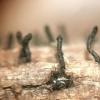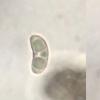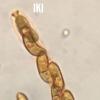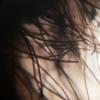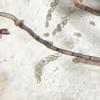
21-01-2026 16:32
Gernot FriebesHi,I need your help with some black dots on a lich

21-01-2026 16:48
Gernot FriebesHi,after my last unknown hyphomycete on this subst

20-01-2026 17:49
 Hardware Tony
Hardware Tony
I offer this collection as a possibility only as e

15-01-2026 15:55
 Lothar Krieglsteiner
Lothar Krieglsteiner
this one is especially interesting for me because

17-01-2026 19:35
Arnold BüschlenHallo, ich suche zu Cosmospora aurantiicola Lite

16-01-2026 00:45
Ethan CrensonHi all, On decorticated hardwood from a New York

18-01-2026 12:24
Hello.An anamorph located on the surface of a thin
Immersed long-necked pyrenomycete - Ceratostomella (?)
Ethan Crenson,
06-11-2018 08:59
In New York City, on wet well-rotted wood. A long-necked black pyrenomycete, with perithecia fully immersed in the wood. Exposed portions of the beaks are shorter than 1mm. Somewhat sulcate. Asci very short stipitate, spore portion 33-43 (-46) by 6-7 (-10)µm. 37-50 (-60)µm in total length. Apical apparatus IKI- refractive ring. Spores light brown in asci when mature with 2 to 3 guttules 7-9.5 by 3-4µm. Hairs mostly unbranched, brown, septate, about 5µm wide. This seemed similar to brown spored sp. in the genus Ceratostomella (s.l.) but I am uncertain. C. rostrata seems to differ in spore size. Any help would be appreciated.
Thanks!
Eduard Osieck,
07-11-2018 11:06
Re : Immersed long-necked pyrenomycete - Ceratostomella (?)
I would suggest to check Réblová’s 2006 paper on Cerastomella and related species. For instance, species of the genus Xylomelasma have brown spores and a sulcated neck. A later paper by the same author includes a key to more long-necked species.
Good luck, Eduard
Good luck, Eduard



